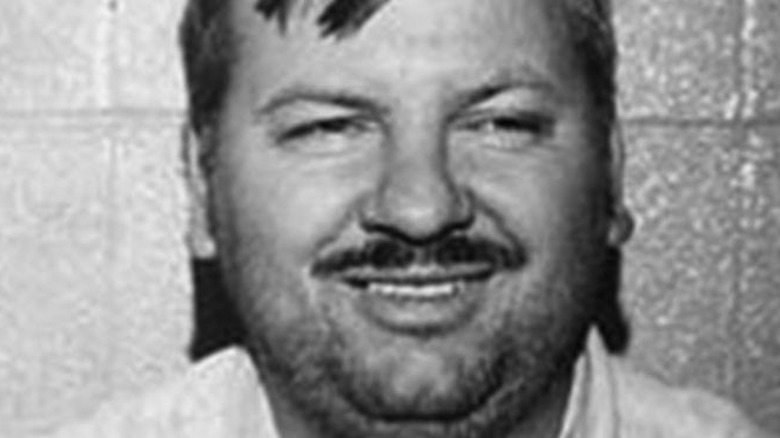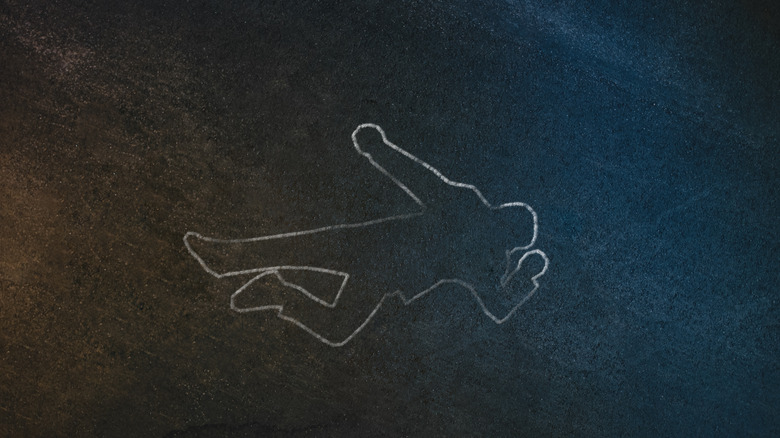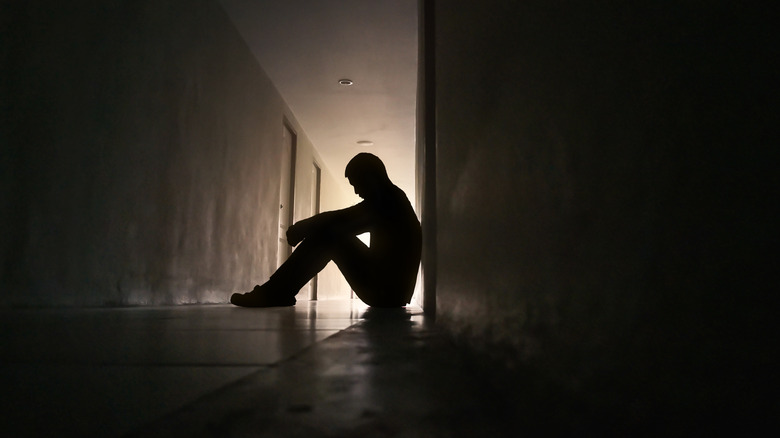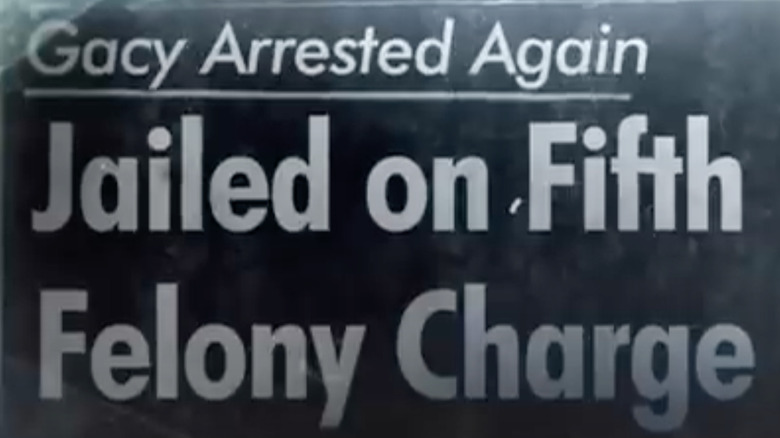Mysteries That Still Remain About John Wayne Gacy
Warning: This article contains references to sexual assault, alcoholism, and murder.
It was March 13, 1980, when John Wayne Gacy was convicted of 33 murders. The former contractor, aspiring politician, and part-time clown seemed guileless until Chicago police searched the cramped crawlspace beneath his house. They unearthed the bodies of teenage boys and young men who were later found to have been sexually assaulted and murdered. Some still remain unidentified, and there are possible victims who were never accounted for. Gacy was sentenced to death and executed in 1994.
The specter of the man often called the "killer clown" still haunts Chicago. Not everything is known about the horrific crimes committed in the darker half of Gacy's double life. Police did not take missing persons reports seriously until they actually found corpses, and there may have been more victims. There is one mother who was told her son's remains were found only to realize he had never been properly identified. She is still searching for him.
From faces without names to the debate over whether Gacy was born a killer or grew into one from years of abuse, alcoholism, and even epilepsy, these are the questions left unanswered.
If you or anyone you know has been a victim of sexual assault, help is available. Visit the Rape, Abuse & Incest National Network website or contact RAINN's National Helpline at 1-800-656-HOPE (4673).
How many lives did he actually take?
The problem with convictions is that they don't always reflect how many crimes were committed. The Peacock documentary "Devil in Disguise" reveals a recording of John Wayne Gacy that may mean he had something to hide. When investigator Rafael Tovar asked the "killer clown" how many people he really killed, Tovar told NBC News that Gacy's response was "45 sounds like a good number." When he asked Gacy where the bodies were, he was met with, "No, that's your job. You got to find out."
It didn't help that Gacy was suspected to have been misleading authorities. Karen Conti, who would eventually be the killer's death-row attorney, remembers him sending police on a labyrinthine search. "That was typical Gacy," she said in "Devil in Disguise." "Sort of like, don't look over here, Look over there." Others who were on the case think he could have buried bodies elsewhere. Conti also said she "thought all along we were going to find more bodies attributed to Gacy."
It is possible that — if there were unknown murders — the bodies were never found because they were thought to exist at the bottom of society's hierarchy. As psychologist Sherry Hamby told Oxygen, Gacy took advantage of this since victims who fall under this stereotype are less likely to be missed.
Did Gacy realize what he was doing or was his judgment blurred?
During John Wayne Gacy's trial, his mental health was debated, but some self-incriminating things he told authorities couldn't possibly be ignored.
Attorney Bob Motta Jr., son of Bob Motta, one of the lawyers on Gacy's defense team, got a hold of unedited interview tapes. "He [had time] to think about what to do about forming some kind of theory for defense in his own mind", the younger Motta reveals in his podcast "The Defense Diaries" (via NBC 5 Chicago). Gacy admitted he would drink heavily and wake up hungover only to find a body on the floor. He had no recollection of killing anybody and blamed either his alter ego, Jack Hanly, or the victims themselves for not knowing better.
Psychologist Donald Black said Gacy had antisocial personality disorder in his book "Bad Boys, Bad Men" (via Stanford University Magazine). Gacy was ultimately deemed to have known what he was doing. The American Justice documentary "John Wayne Gacy: Buried Secrets" recalls that witnesses who testified led the prosecution to believe "Gacy proved his own sanity by leading an outwardly normal life while killing young men."
If you or someone you know is struggling with mental health, please contact the Crisis Text Line by texting HOME to 741741, call the National Alliance on Mental Illness helpline at 1-800-950-NAMI (6264), or visit the National Institute of Mental Health website.
What was he doing outside an apartment complex in the middle of the night?
At one point, John Wayne Gacy worked as a maintenance man in a Chicago apartment complex not far from where he lived. Former homicide detective Bill Dorsch started to grow leery when he ran into Gacy around 3 a.m. on a snowy night and noticed what he had clutched in one hand (via The Verge). It was not a snow shovel but a spade, which aroused Dorsch's suspicions that Gacy might have been digging in the dirt for whatever reason instead of clearing out snow. Gacy tried to pass this off as being a workaholic.
Dorsch couldn't shake the suspicion and called the sheriff's office. He met with investigators and told them "about knowing Gacy and seeing him ... around 3 a.m. holding a shovel," as he told The Shadow Reports. Dorsch realized he had been right to suspect something after bodies were dug up from the crawlspace beneath Gacy's house and recovered from the Des Plaines River, but it was years after Gacy's execution that Dorsch learned the Cook County Sheriff's office had done absolutely nothing.
Later, a 1998 radar scan around the complex revealed possible evidence of human remains, and Dorsch was the one who pushed for that to happen.
Did Gacy commit every murder alone or did he have accomplices?
There are still mysteries surrounding whether John Wayne Gacy himself killed every one of his victims. Some believe he acted alone. As Alec Wilkinson wrote in The New Yorker a year after Gacy's execution, Gacy insisted he "couldn't have buried any of the bodies in the crawl space" because he was out of shape.
Gacy tried to assert his innocence through claims of mental illness and pointing his finger at possible accomplices. According to Wilkinson, Gacy used his remodeling company as a cover for going out at night and pointed to his employees David Cram and Michael Rossi after 27 bodies were discovered in the crawl space under his house. They were never convicted of any crimes — but no conviction doesn't necessarily mean no guilt.
Gacy only seemed to be an upstanding citizen by day. After dark, he would stalk the neighborhood for potential teenage victims and lure them into his car with a fake police badge (via "John Wayne Gacy: Buried Secrets"). Cram and Rossi were never proven to have been accomplices in the murders.
Did something shift inside Gacy to make him kill?
It is possible that things that happened to John Wayne Gacy irreversibly changed him. Richard Rappaport, chief psychiatrist for the defense, told A&E True Crime that Gacy was ruthlessly abused by his father (who was a heavy drinker). As his sister Karen told reporters in "Devil in Disguise," while John was not the only one to succumb to his father's violent outbursts, he was still the main target. "When he drank too much, John got the brunt of it," she said.
A 1984 study published in University of West Virginia Law Review examines whether epilepsy also had something to do with Gacy's behavior. Gacy was 20 when he first went to the hospital complaining of back pain and headaches. Records referenced in the study say he had "'hysterical' blackouts during which [he] remember[ed] nothing but others said he began to shake intermittently." Hospital staff needed to hold him down and sedate him, and he no longer remembered what had happened after about a week.
Gacy's violent seizures continued. In the following years, he ended up hospitalized several times, attacking staff as he did before, and he was given strong sedatives to keep him from possibly inflicting harm on anyone. Whether he slipped into such blackouts when he killed is still unknown.
If you or someone you know is dealing with domestic abuse, you can call the National Domestic Violence Hotline at 1−800−799−7233. You can also find more information, resources, and support at their website.
How did he get away with murder for so long?
John Wayne Gacy was deceptive because he seemed like the last person anyone would suspect. When Joe Berlinger — who directed the Netflix documentary "Conversations With a Killer" — spoke to Netflix Tudum, he said, "Just because somebody looks trustworthy doesn't mean they are. And I think Gacy epitomizes that."
According to History, there seemed to be nothing off about a man who, despite a 1968 stint in prison for sexual assault and a failed marriage, appeared to have it together. He was such a model prisoner he was released early, and Chicago lauded him for standing out in the community. He remarried, had children, and in addition to fronting his own remodeling company, he was a local politician. As reported by Inside Edition, Gacy would also put on a clown act for parties, and it seemed innocuous. Gacy would go on to murder some of his victims in that very same costume, earning him the nickname "killer clown."
Another reason Gacy almost got away with taking (at least) 33 lives is that many were thought to be runaways or male sex workers, according to "Devil in Disguise." There was no outrage over young men going missing when they were already assumed to have taken off on their own. It didn't help that they were mostly gay men — highly stigmatized at the time. As a WLS-TV reporter said in a 1978 clip included in the documentary, "They came to him either paid or looking for a good time and got more than they bargained for."
Was there any truth to his claims of innocence?
Alec Wilkinson told The New Yorker that John Wayne Gacy was "obsessively fond of defending his innocence, which is imaginary."
Gacy often spoke to the media — but insisted he had not committed most of the murders. Some of this is revealed in a transcript from a CBS News interview with Gacy not long before he was executed. The prolific killer insisted there were several reasons he couldn't have been responsible and pointed to his image as a family man. He admitted to so much as knowing about five of the murders and said he was no more than an accomplice who threw one of the bodies in the river, despite the fact that he confessed much more incriminating things to the police right after he was arrested. Even his claim of taking the "truth serum" — otherwise known as sodium amytal — is thought to have been a lie.
Joe Berlinger, director of the Netflix Documentary "Conversations With a Killer: The John Wayne Gacy Tapes," knew Gacy kept lying in his interview but didn't stop the camera. As Berlinger told Netflix Tudum, he wanted the killer to keep going because "listening to how he spun things is a fascinating portrait of a sociopath, because a sociopath feels no remorse and always blames other people."
Were some of the victims killed on camera?
While John Wayne Gacy may have lied about his innocence, that doesn't mean he operated alone. He apparently associated with other criminals who hunted teenage boys. According to the Toronto Sun, another employee of his, Phillip Paske, sparked the suspicion of the police.
It turned out that Paske's boss was notorious child sex offender John David Norman. Not only did Norman sell child pornography, but he also ran a sex trafficking ring for men seeking much younger prey. As the Toronto Sun notes, "The Candyman" Dean Coryll, who had 28 known victims, was supposedly another accomplice of Norman's and also one of his customers before Gacy entered the scene. Police eventually found out that two of Gacy's victims were last seen alive with Norman. This pushed them to investigate further and led them to think Gacy was somehow involved with Norman and procured young victims from him.
As Gacy's death row attorney Karen Conti recalls in "Devil in Disguise," Gacy tried to shift at least some of the blame to Norman and "alluded to the idea that ... there may have been a snuff film operation and that some of these young men and boys were being killed and videotaped." Gacy denied any involvement. Conti initially found it hard to believe him, but she soon realized that the possibility of a thriving black market for these films in the '70s meant there might have been truth to this.
Did the police do enough?
There have been arguments that the police refused to believe what was going on. Jeffrey Rignall was one of John Wayne Gacy's few surviving victims, and according to The Crime Library (via the Clark Country Prosecutor's Office), Rignall was sedated with chloroform and would intermittently wake up to see a naked Gacy sexually abusing him. When Rignall informed the police, they didn't exactly believe him.
Local authorities remained in denial of the horrific crimes happening around them. As RET News anchor Jay Levine told Peacock in "Devil in Disguise," gay men faced a massive stigma during the '70s. And because they "were kind of an underclass," when it came to the case mounting against the deceptive killer, this stigma "affected the way it was reported and the way it was treated by law enforcement." Most of Gacy's victims are now believed to have been either male sex workers or gay men he randomly picked up.
Making the victims seem like runaways only worked against them, and the police usually brushed off the missing person reports, even though Gacy was often linked to those cases. Sometimes detectives even went off what Gacy told them when they questioned him. If he was caught, he was soon released, only to kill again and again.
If you or anyone you know has been a victim of sexual assault, help is available. Visit the Rape, Abuse & Incest National Network website or contact RAINN's National Helpline at 1-800-656-HOPE (4673).
Were sex acts between Gacy and his victims consensual as he claimed?
Before John Wayne Gacy ever turned into a serial killer, he served what was supposed to be a 10-year prison sentence for sexually abusing a minor, then called "morals charges" in the local newspaper (via newspapers.com). He was also involved in politics at the time. Insisting that the teen had consented, he tried to turn the attention of police to members of a political group he headed (via Crime + Investigation). Gacy said the accusations had been made up by members of that group who wanted to see his downfall.
If what happened between Gacy and the teenage boy, Mark Miller, was consensual, then why did Gacy set an attacker on Miller after eluding law enforcement? Gacy finally pled guilty to the sexual abuse charge. "Devil in Disguise" reveals that he also tried to convince police what happened with Jeff Rignall was consensual, and they bought it.
Even after the murders, Gacy was still appealing other charges of sexual abuse and assault, which is documented in the 1984 cases Nieder v. Gacy and People v. Gacy (via the Clark Country Prosecutor's Office), which also detailed "numerous other incidents of sexual torture and physical abuse." In "Devil in Disguise," Rafael Tovar, who was then a detective with the Des Plaines Police, told Peacock he remembers that after Jeff Rignall pleaded for help, his colleagues dismissed the claims because they assumed "all sexual arrangements between gay people were consensual."
Who really was Victim No. 14?
Michael Marino was 14 and on his way to a nearby arcade when he vanished around the same time that John Wayne Gacy was luring in victims only to kill them. USA Today reports that he was first dismissed as a runaway, but police later apologized to his mother, Sherry Marino, telling her that one of Gacy's victims had been identified as her son. It didn't end there.
Forensic odontologists thought they had found Michael's body after dental analysis, and the radiologist who X-rayed the remaining bones came to the same conclusion. But Sherry Marino was far from finding closure. She felt that whoever was buried under the headstone with her son's name was not actually Michael but another victim who had been mistaken for him. Sherry had reasons to believe that Michael had never been found, including a collarbone injury in the victim's medical records — something that had never happened to her son — and the lack of a DNA match. The problem was that the DNA test was not considered legitimate.
The identity of victim No. 14 remains a mystery. Michael's friend, Kenneth Parker, who was headed to the arcade with him, was Gacy victim No. 15, as the Chicago Tribune mentions. Though the death certificate in Michael's name cannot be changed unless there is indisputable forensic evidence that the remains thought to be Michael's actually belong to someone else, his mother still has a feeling the remains were misidentified.
Where are the unidentified victims?
There is no evidence for the additional victims John Wayne Gacy claimed to have killed and then teased police about. However, among his 33 known victims, five have still remained unidentified since the case that was closed after his 1993 execution was reopened in 2011.
In late 2021, ABC57 News put out a call for anyone who could help put names to the faces of these victims after a sixth body was finally identified as Francis Wayne Alexander earlier that year. The news channel also shows facial reconstructions of what two of the teenage victims would have looked like. These sketches were released by the National Center for Missing and Exploited Children in 2018, along with whatever details could be made out from their remains, such as dental fillings.
The Cook County Sheriff's Office also asks for help in identifying these victims from anyone directly related to them who might be able to offer a DNA sample that could make a connection to one of them. They also want to hear from anyone who "had a male relative go missing between 1970 and 1979." Gacy was released from a previous prison stint in 1970, and after that, young men kept disappearing from areas around Chicago.












